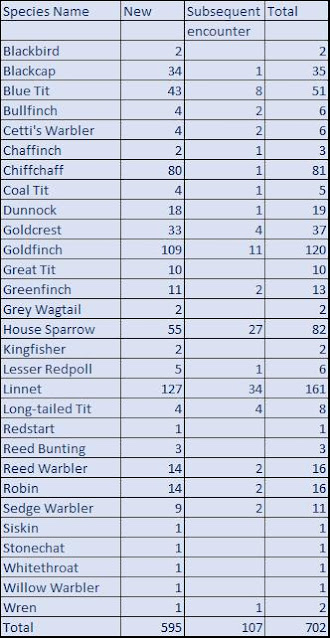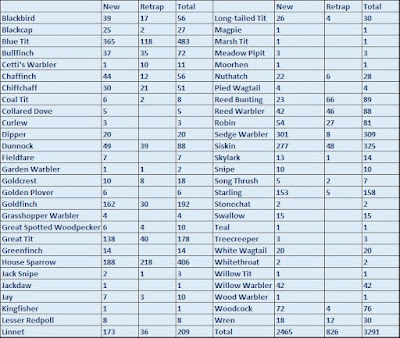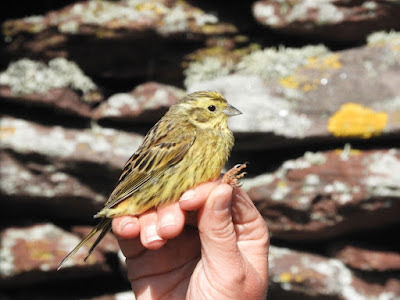Since moving to Carmarthenshire in late 2017 and through
until the end of March 2022, 1814 Starlings have been ringed in our garden just
south of Llandysul. Birds have been processed between the months of October to
March each winter with the highest winter period total being 569. Very few birds
are seen in the area (home +5km radius) during the summer months but small
numbers are known to successfully rear young most years although these local
breeders and offspring seldom visit the garden in the months from April to
September. The main purpose behind ‘a push’ on ringing the Starlings was to try
to establish to what degree birds were returning each winter given their
virtual absence during the breeding season. Mist netting produced many of the
initial bird captures but with the tendency of Starlings to alarm call during
extraction, this method of catching was not considered to be ideal if
reasonable numbers were to be ringed. A manually operated drop trap was put
into service and was very productive but this method is time absorbing and new birds
cannot easily be caught while a catch is being processed. Walk-in traps have also
been used with some success and Potter traps have also been quite productive.
Since 2017, five birds with rings fitted elsewhere have been
processed in the garden: 2 from Lithuania, 1 from Germany, 1 from Belgium and 1
from Kent, UK. Three birds ringed in the garden have been reported from
elsewhere: 1 found dead in Ceredigion during the same winter period, 1 found freshly
deceased in Carmarthenshire during the subsequent winter period, and one intentionally
taken by a ringer in Holland 2 years after ringing. These records suggest an East/West
seasonal movement of an unknown proportion of the birds encountered but there
is little evidence to suggest anything further.
The number of birds re-trapped in the garden has, in my
opinion, been low: 12 individuals (0.66%) have been subsequently encountered
within the same winter period and an additional 6 birds (0.33%) have been
subsequently encountered in winter periods that have followed original ringing
dates (5 re-trapped, 1 ring read). These occurrences could make one think that
there is simply a low rate of return of individual birds.
Over a period of seven consecutive days of settled weather
in December 2022, I conducted a small trial in the hope that I may be able to
understand a little more about the Starlings re-visiting our garden.
Day 1, 11/12/2022 – watching and
taking photographs of metal rings
LR08093 sighted, ringed 25/11/2021
LC93396 sighted, ringed 12/12/2017
Day 2, 12/12/2022 – watching and
taking photographs of metal rings
LR08037 sighted, ringed 18/11/2021
LL72965 sighted, ringed 03/12/2018
LR08315 sighted, ringed 02/11/2022
Day 3, 13/12/2022 – watching and
taking photographs of metal rings
LL86687 sighted, ringed 23/11/2020
LL86718 sighted, ringed 30/12/2020
LL86621 sighted, ringed 26/10/2020
LR08318 sighted, ringed 02/11/2022
Day 4, 14/12/2022 - ringing using
a single 3 bay potter trap
21 new starlings ringed, 0 re-traps
Day 5, 15/12/2022 - ringing using
a single 3 bay potter trap
7 new starlings ringed, 0 re-traps
Day 6, 16/12/2022 – watching and
taking photographs of metal rings
LR08037 sighted, already re-sighted
on Day 2
LL86971 sighted, ringed 15/11/2021
LR08093 sighted, already
re-sighted on Day 1
LL86526 sighted, ringed 02/03/2020
LL86961 sighted, ringed 07/11/2021
LR08365
sighted, ringed 15/12/2022
LR08351 sighted, ringed 14/12/2022
LR08340 sighted, ringed 14/12/2022
Day 7, 17/12/2022 – ringing using
a three-port entrance walk-in trap
5 new starlings ringed, 2
re-trapped
LR08350,
ringed 14/12/2022
LR08351, ringed 14/12/2022
LC93396
LR08093
LL72965
One of the many partial ring reads!? Half a dozen shots taken
as the birds move around often allow the ring to rotate slightly and these can
be viewed together for a full ring combination. Many birds just move about too
quickly and simply fly off. The general wear on the ring indicates that it hasn’t
been fitted recently.
Discussion
The ringing activity during this brief study brought the
total number of birds ringed during the current winter period to 51.
During the small trial, fifteen individuals have been identified
from metal rings of which five have been ringed in this winter period with
three being re-sighted within two days of ringing. No ringed birds entered far
enough into the Potter trap to trigger the door release mechanism whereas two
recently ringed birds (initially caught in the Potter trap) entered the Walk-in
‘maze’ trap.
In just four days of observation (each session lasting 2-3 hours), birds have been re-sighted from each of
the preceding winter periods of ringing and the 10 ring reads far outweighs the
number of physical re-traps (five) that have been achieved over the entire four winter periods.
Photographing metal rings isn’t the easiest thing to do. Starlings
often feed near each other with frequent movements among individuals and partial
ring reads regularly occur. I am in no doubt that the number of individuals
seen over the four days was greater than the number of rings read. At least one
individual was carrying a continental ring.
The result of this work doesn’t help me to understand where
any of these birds spend the breeding season but it does prove that a higher
proportion of birds revisit our garden as part of their winter survival
strategy than standard recapturing methods alone have indicated.
Although I believe Potter traps and other ground-based traps
are quite successful for the ringing of new birds, I am left with little doubt
that they are not an effective way of retrieving data which is of course the
purpose of any mark-recapture project.
A methodology that considers more than just a single themed
approach to catching is likely to be rewarded with a greater quantity of data
for this intelligent and adaptable species.
















































.JPG)